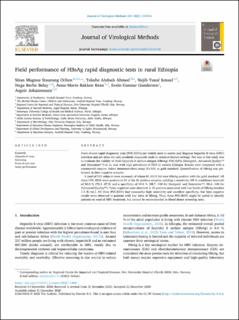Field performance of HBsAg rapid diagnostic tests in rural Ethiopia
Orlien, Stian; Ahmed, Tekabe Abdosh; Ismael, Nejib Yusuf; Belay, Nega Berhe; Kran, Anne-Marte Bakken; Gundersen, Svein Gunnar; Johannessen, Asgeir
Peer reviewed, Journal article
Published version
Permanent lenke
https://hdl.handle.net/11250/3069630Utgivelsesdato
2020Metadata
Vis full innførselSamlinger
Originalversjon
Orlien, S., Ahmed, T. A., Ismael, N. Y., Belay, N. B., Kran, A.-M. B., Gundersen, S. G. & Johannessen, A. (2020). Field performance of HBsAg rapid diagnostic tests in rural Ethiopia. Journal of Virological Methods, 289, 1-4. doi: 10.1016/j.jviromet.2020.114061Sammendrag
Point-of-care rapid diagnostic tests (POC-RDTs) are widely used to screen and diagnose hepatitis B virus (HBV) infection and are often the only available diagnostic tools in resource-limited settings. The aim of this study was to evaluate the validity of three hepatitis B surface antigen (HBsAg) POC-RDTs (Healgen®, Advanced Quality™ and Determine™) in an area with high prevalence of HBV in eastern Ethiopia. Results were compared with a commercial enzyme linked immunosorbent assay (ELISA) as gold standard. Quantification of HBsAg was performed in false negative samples. A total of 511 subjects were screened, of whom 81 (15.9%) were HBsAg-positive with the gold standard. All three POC-RDTs were positive in 65 of the 81 positive samples, yielding a sensitivity (95% confidence interval) of 80.2% (70.3-87.5) and a specificity of 99.8% (98.7-100 for Healgen® and Determine™; 98.6-100 for Advanced Quality™). False negatives were observed in 16 patients associated with low levels of HBsAg (median 1.5 IU/mL). All three POC-RDTs had reasonably high sensitivity and excellent specificity, but false negative results were observed in patients with low titres of HBsAg. Thus, these POC-RDTs might be useful to identify patients in need of HBV treatment, but cannot be recommended as blood donor screening tests.

